Pooley & Son
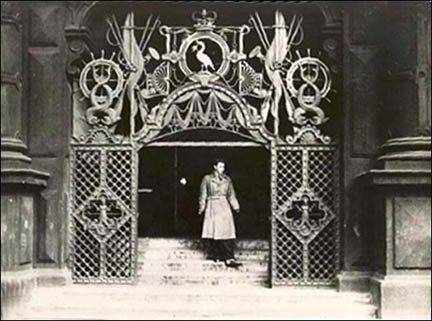 Henry Pooley (1803-78) was born in West Derby, a suburb of Liverpool. He was the third son of Liverpool iron founder Mr Henry Pooley Snr. Henry Pooley (1803-78) was born in West Derby, a suburb of Liverpool. He was the third son of Liverpool iron founder Mr Henry Pooley Snr.
Henry Jnr. studied his craft as apprenticed to his father under whose guidance he became an expert in the use of tools (for making patterns). In his spare time young Henry studied science and art, he attended drawing at classes under “the father of Mr. Spence, a sculptor of Rome.”
On completion of his seven years' apprenticeship Henry took an active part in the management of his father’s business. Initially, he worked on the production of stoves, heating and ventilating apparatus and machinery of various kinds. Henry’s designs were noted for a strength of form with simple elegance and lightness of appearance though unusual at the time, a period when art and design were seen as separate disciplines. In 1830 Henry went into partnership with his father and the company changed its name to 'Henry Pooley & Son'.
Mr Pooley's success was built from a combination of his talent for design and good fortune. In 1832, he was persuaded to add the manufacture of weighing machines as a minor addition to his business, not thinking that this step would totally change the character of his operations. But the construction of the Liverpool and Manchester railway, quickly followed by the extension and completion of other lines, created a massive demand for new methods for handling and rapidly weighing goods.
Seeing the potential, Pooley used his ingenuity and resource to enable him to exploit this new trade by developing equipment for not only weighing goods of all kinds but even railway engines. In 1846 Mr Richard Trevithick, the locomotive superintendent at Crewe, consulted him on the subject of balancing locomotive engines by actual weight and he arranged and made the first multiple weighing apparatus ever used for this purpose.
Pooley’s innovative designs were imitated by other companies, nevertheless his business extended rapidly. By his father's death, in the year 1841, he was left at the head of a large concern which continued to grow.
In his later years he took an active interest in improving public health and helped to build a number of public baths and washhouses in Liverpool and Chester.
By the time of Henry Pooley Junior’s own death in 1878, 'Henry Pooley & Son' had become the country’s largest manufacturer of weighing equipment. In 1900 the company moved its head office from Liverpool to Birmingham and in 1931 the company was absorbed into W. & T. Avery. Pooley’s Albion Foundry, which had stood on Manchester Street, close to Liverpool city centre, was finally demolished to make way for the construction of the Liverpool City entrance of the Mersey Tunnel.
Pooley, Cunningham and The Liverpool Sailors’ Home
The Liverpool Sailors’ Home project was launched at a public meeting called by Liverpool’s Mayor in October 1844. The need for a Sailors’ Home had been identified:
“to provide for seamen frequenting the port of Liverpool, board, lodging and medical attendance, at a moderate charge; to protect them from imposition and extortion, and to encourage them to husband their hard-earned wages; to promote their moral, intellectual, and professional improvement; and to afford them the opportunity of receiving religious instruction. A reading-room, library, and savings bank will be attached to the institution; and with a view to securing to the able and well-conducted seamen a rate of wages proportionate to his merits, a registry of character will be kept. Among the ulterior objects in contemplation are schools for sea-apprentices, and the sons of seamen, with special regard to the care of children who have lost one or both their parents' receiving religious instruction.”
As well as providing safe accommodation for an average of 200 men each night, the home provided a vital service, introducing professional, experienced merchant seamen to captains of safe seaworthy vessels. This combined with the expansions of its docks, greatly improving the reputation and efficiency of Liverpool as a merchant port.
Liverpool-based architect John Cunningham (1799-1873) was involved with the Liverpool Sailors’ Home project from the institution’s inception, having been appointed architect of the building in 1844 even before land for the building had been secured.
Originally from Scotland, from his arrival in the city in 1834 until his retirement in 1872, Cunningham designed a number of the City's most important buildings including the first railway stations at Edge Hill and Lime Street, the Philharmonic Hall and the Liverpool Sailors’ Home.
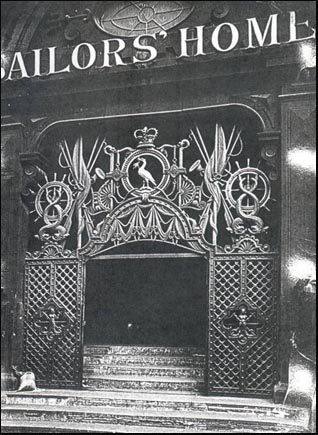 During the construction of The Liverpool Sailors’ Home (1845-52), it is clear from contemporary reports that John Cunningham, worked closely with Henry Pooley Jnr. on the designs of the iron-work: “three tiers of ornamental cast-iron pilasters with an intermediate range of galleries, filled in with ornamental cast-iron work depicting nautical themes characteristic of the purpose of the building, thereby forming six floors for dormitories, capable of accommodating on each floor forty-four cabins.” Pooley and Cunningham also worked together to re-build the Homes’ interior following the disastrous fire of April 1860 which closed the building for two years. During the construction of The Liverpool Sailors’ Home (1845-52), it is clear from contemporary reports that John Cunningham, worked closely with Henry Pooley Jnr. on the designs of the iron-work: “three tiers of ornamental cast-iron pilasters with an intermediate range of galleries, filled in with ornamental cast-iron work depicting nautical themes characteristic of the purpose of the building, thereby forming six floors for dormitories, capable of accommodating on each floor forty-four cabins.” Pooley and Cunningham also worked together to re-build the Homes’ interior following the disastrous fire of April 1860 which closed the building for two years.
Despite later accounts of his success, Pooley's relationship with the Home was not always a smooth one. Pooley’s heating apparatus for the building was not finished on time and even when completed, for the Homes’ belated opening in the winter of 1852, was described by the Sailors’ Home Committee as not fit for purpose.
Another piece of Pooley and Cunningham’s handiwork had a flaw which resulted in rather more than inconvenience.
The Gates
The entrance gates to the Sailors' Home served the dual purpose of protecting the Savings Bank and keeping out seamen who might wish to gain entry to the Home after the strict 10pm curfew.
By April 1852 the lower sections of the gates had been installed, decorated with a combination of elements from the interior balconies; four great panels of rope-work with central mermaid and trident figures identical to those inside. The two outer panels were fixed whilst the two centre sections rolled behind them on rails where they were hidden from sight while the Home was open for business.
The iron-work of the lower gates, being on such a large scale, produced a solid, intimidating aspect compared with the much lighter appearance of the balcony railings. The huge mass of iron made an impassable barrier but also a massive weight and it would have taken some effort to slide the gates open and close.
The upper part of the gates which reflect the sandstone carvings above the entrance were added later and show a much lighter touch, using the spaces between the iron to great effect. The Minutes of Sailors' Home Management Committee contain the following entry:
April 25th. 1852 - "Mr Akin laid upon the Table a note from Mr.Pooley and 2 notes from Mr. Cunningham with a plan for supporting the arch over front gate way. When the superintendent expressed his fears as to the consequences which might result from the proposed spikes upon the top of the gate to drunken belated boarders, and also as to the sufficiency of pillar supports resting upon the top of the gate itself. After some consideration, the matter was referred to Mr. Mann who kindly offered to consult with Mr. Cunningham. "
By the following meeting on May 3rd Cunningham had confirmed that he would alter the plan for supporting the front arch and on May 24th he was given permission to proceed with the alterations to the front gateway. It was agreed that Mr Pooley would have the contract.
Although spikes, so frowned on by the Committee, were fixed to the top of the original gates, Cunningham and Pooley's new upper section elegantly blocked all the area above the entrance making access impossible when the gates were closed. They also supported the stone work of the entrance arch, which appears to have had a structural weakness.
1852: An Unfortunate Death of Mary Ann Price
The Minutes of the Sailors' Home Management Committee contain the following entry:
“1852 July 14th - "Mr. Cunningham and Mr. Pooley were present in reference to the accident of the falling of the outer gate upon Mrs Price, causing her death.
From the explanations given, it seems to have arisen in the neglect of Mr. Pooley's foreman to replace the stop which was carried away when the gate fell before and in the hook attached to the chain having by frequent jerking opened and become detached from the loop upon the gate.
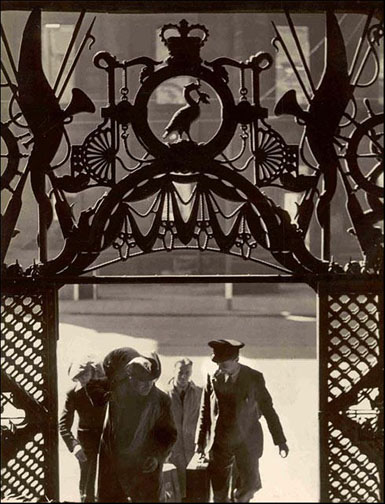 Resolved - That Mr.Cunningham & Mr.Pooley arrange an effectual stop for front gate, and that they give a note conjointly, to the effect that the gate shall be made perfectly secure." Resolved - That Mr.Cunningham & Mr.Pooley arrange an effectual stop for front gate, and that they give a note conjointly, to the effect that the gate shall be made perfectly secure."
The report of the inquest before P.F.Curry on the death of Mrs Price, which appeared in The Liverpool Courier July 14th 1852 failed to mention Pooley's neglect:
“Mary Ann Price, 52 years of age. John Price, the husband of the deceased, is porter at the Sailors' Home. On the night of Sunday the 12th, between eight and nine O'clock, he was closing the ornamental gate,(which is massive iron, and divided into three compartments) with his wife, his daughter, and her child, standing by his side. There was a chain which should have been hooked on to the wall to prevent the gate sliding out of the grooves but this must have been detached by some person unknown to him during the period of divine service. He was shutting the gate in the usual way, when the centre compartment slipped out of the groove and fell upon his wife and daughter, both of whom were taken to the South Hospital where the deceased died next morning from the injuries which she had received.”
Right: checking int the Sailor's Home in 1938
The verdict of the inquest was that Mrs Price had been "Accidentally Killed".
Not only had the gates fallen off prior to killing the unfortunate Mrs Price, but even after her death Pooley's were slow to react;
"Resolved - That a note be sent to Mr.Pooley to remind him, and to express the extreme disappointment of the Committee that this has been neglected after the late lamented accident.”
Minutes of the Sailors’ Home Committee Meeting July 21st 1852:
Despite the obvious mechanical problems causing of the fatal accident, The Home’s Committee thought that action should be taken against the individual responsible for the gate falling. It was not Mr Pooley or his foreman that were brought to account but the unfortunate doorkeeper, Joseph Clark who was suspended and replaced by William Elliot at 18/- per week.
This might have been all that could be written about Cunningham and Pooley’s entrance gates until their removal after World War 2, but lightning was to strike twice.
1907: The Tragic Death of Constable Locke
In the Annals of the Sailors' Home, printed in the Home's annual report for the year 1935, against the year 1907 was the following entry:
November - Police Officer Locke killed through front gate falling upon him. The following is taken from contemporary accounts:
“Early on the morning of Sunday the 24th of November, nearly an hour after midnight, Police constable number 324A, Brownlow Locke, of the Liverpool City Constabulary, met his death in a very strange and unexpected manner.”
“Constable Locke had gone on duty at 5.45pm. on Saturday evening. A heavy downfall of hail occurred at the time when the porter of the Sailors' Home came out to close the outer gate, which was a solid and heavy iron structure, opened and shut by being wheeled across the opening. The constable, it appears, had left his waterproof cape at another part of his beat, and had stood inside the entrance of the Sailors' Home to shelter from the storm. Seeing the porter unable to pull the mid section of the gate into place, the officer went to his assistance but had evidently given so strong a pull that the gate had run sharply and snapped the hold back chains, one of which was tied with rope. The gate overshot the guide and toppled outwards from the top. The porter during the operation was inside and the policeman outside the gate. Seeing it begin to fall over, the porter made a grab at it, but was overpowered by the heavy mass, and sustained some injury in being carried with it, while the officer, being beneath, sustained the whole impetus of the downfall. Being a mass of metal weighing about half a tonne, the gate crushed the officer so severely that he was at once rendered unconscious.”
“When removed on the ambulance to the Royal Southern Hospital it was found that the injuries, consisting of a fracture of the 'scull' and internal injuries, so serious as to preclude the hope of recovery. About 1.30 on Sunday morning Thomas Locke, who was also a constable in the City Force, was informed that his brother had been injured and taken to Hospital. He immediately proceeded to the institution. His brother, who was unconscious, expired a few minutes after he arrived. Locke, who originally came from Widnes, was described as a very promising officer of twenty six years of age, who had four years service. He left a widow and one child. The victim of the calamity was the fourth member of his family in police service, two brothers serving in the Liverpool Constabulary and one in St. Helens.”
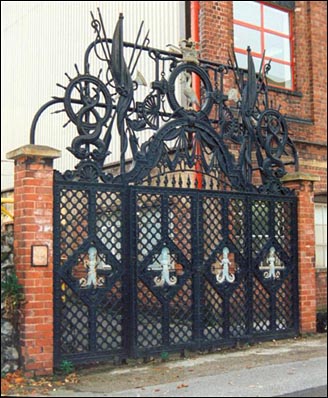 “The heavy mass of iron which caused the officer's death lay prone alongside of the front of the building for some time and was an object of curious investigation by morbid passers-by who knew of the sad affair.” “The heavy mass of iron which caused the officer's death lay prone alongside of the front of the building for some time and was an object of curious investigation by morbid passers-by who knew of the sad affair.”
“Constable Locke was buried three days after the accident at Anfield Cemetery. The coffin was conveyed from his home in Rutland-street on one of the Fire Brigade's hose carriages, which was covered with wreaths. About 200 of the deceased's colleagues in uniform followed the cortege. Large numbers of people assembled all along the route. The neighbourhood of the deceased was crowded by sympathetic friends. The chief mourners were the widow and the mother of the deceased and his three brothers (Police-constables Robert, Alfred, and William Locke). Many police officials also attended included two Chief Superintendents. Among others present was Mr Hanmer, the manager of the Sailors' Home. Wreaths were sent from the Liverpool Police Divisions and from the Sailors' Home.”
“At the inquest on the constable’s death, Mr. A.E. Frankland representing the Home, stated that 'he wished to take the opportunity on behalf of the management of the Sailors' Home of expressing their great regret at the accident and also their deep sympathy with the deceased's relatives'.
55 years after the death of Mrs Price the repairs performed by Mr Pooley's foreman had failed and the gates had claimed a second victim.”
Despite fierce public declarations on December 5th the Committee met to consider the suggestion of Mr Duder's (the prosecuting solicitor) that the Home should make an offer to the Policeman's widow. After discussing the matter and consulting with Mr. Pedder who advised there was no legal liability in the matter, it was decided that he should see Mr Duder and repudiate liability but ascertain whether the widow would be prepared to accept an ex gratia payment as a mark of the Committee's sympathy - any such payment to be without prejudice in every way to the legal position of the Committee of the Home. The secretary was instructed to have the gate inspected by Killick and Cochran and to obtain from them an estimate for “making it secure against such an accident in future".
At the next meeting of the Committee on December 23rd:
"The Chairman reported that in regard to the Policeman's widow, the matter was still in process of settlement. The Chairman presented Messrs. Killick and Cochran's suggestion an estimate for placing a new wrought iron top guide rail for gates, the Secretary was instructed to request them to proceed with the work at once and to ascertain if they consider the ground runners in good order and also if the new chains supplied by them had been tested and to what extent. A certificate was obtained from the Mersey Chain Testing Works, dated January 21/08 giving the test applied to the chains of the front gate as proof strain applied 6 Cwt, Safe load 3 Cwt the secretary reported that Messrs. Killick & Cochran had told him the chains were amply strong for the purpose. At the same time the Chairman presented the report and balance sheet for 1907, which was passed subject to £ 100 being carried to a suspense to cover a grant for Policeman Locke's widow and costs.”
Other authorities also made provision for the Constable's widow, but they were not overgenerous. The Merseyside Police Pensions Index for January 20th 1908, records a gratuity of £25 4 shillings paid to Ellen Locke widow of Constable Locke aged 25.
(Thanks to Tony Mossman of the Liverpool Police).
Visitors to Anfield Cemetery will look in vain for any monument to Constable Locke, whose grave is unmarked despite the unusual nature of his passing and the pomp and ceremony of his burial.
Disturbed by the death of Constable Locke the Chairman approached the Homes' solicitors Messrs. Weightman, Pedder & Co. to determine their liability with regards to third parties having accidents whilst in the Home. The news was not good for the individual Committee members. They were personally liable for the consequences of the negligent action of their servants and liable for injuries happening in consequence of the defective condition of the premises. Fearing the financial penalties in the event of other accidents the Committee quickly resolved that a policy be taken out for £1000 for anyone accident and a maximum of £2000 in one year. Records do not show if a claim was ever made against this policy.
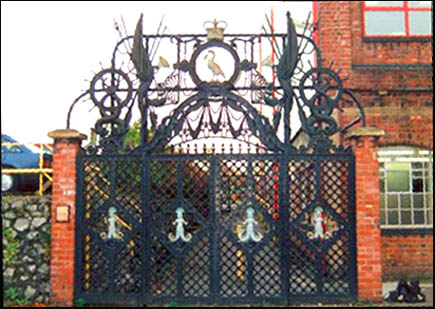 1951: The Gates Move to Their New Home in Sandwell 1951: The Gates Move to Their New Home in Sandwell
As part of the repair to War Damage following the Liverpool Blitz it was decided to remove the gates. On March 25th 1948 W & T Avery who had swallowed-up Pooley's and Sons were offered the gates by the Sailors' Home Committee. On May 18th 1949 Avery's made an offer of 50 guineas for the gates, which was accepted on May 3rd. 1951.
On June 11th 1951 it was reported that the gates were 'quite improperly' holding up the archway above them, and considerable work would be necessary before they dare be removed by the Sailors' Home Contractors. Despite this report the gate had been in place for nearly one hundred years and had supported the entrance arch, just as John Cunningham and Henry Pooley Jnr. had intended when they set down their plans in April 1853.
On December 1st. 1951 the gates were finally loaded on to a lorry for transport to the Avery Historical Museum in Soho Birmingham. These magnificent gates were altered to swing open like conventional doors rather than slide apart as originally intended; the chains which would have prevented them sliding too far are however still present.
The gates are now no longer used, the mermaids on the four iron panels have suffered fin loss and other signs of damage which photographs show occurred before the 1930s. This may be malicious damage caused by seamen angry at being locked out of the Home after curfew, or during the three occasions, two of them deadly, when the chains failed to stop the massive doors coming off the rails.
2010: What Next for the Gates?
In the summer of 2010, following Sandwell MBC’s concerns about the condition of the gates and corrosion of their supporting structure, the structure was dismantled and taken to Barr & Grosvenor Ltd’s foundry in Wolverhampton for restoration under the guidance of the company’s head, Dominic Grosvenor. The £32K estimated cost of the restoration is being borne by Avery and it is hoped that the gates will be returned to Avery’s historic Soho Foundry site in October 2010.
Author Stephen McKay has been so kind as to allow us to reproduce the above essay on our website. He asks us, however, to make it clear that his work, the result of twenty years' research, remains strictly copyright and may not be reproduced without talking to him first: portmeiriana@hotmail.com
Update
The Pooley Gateway was returned to Liverpool in 2011 by the City Council, supported by the city's retired merchant seamen. It has now been put on permanent display in Paradise Street, close to its original location outside the Sailor's Home.
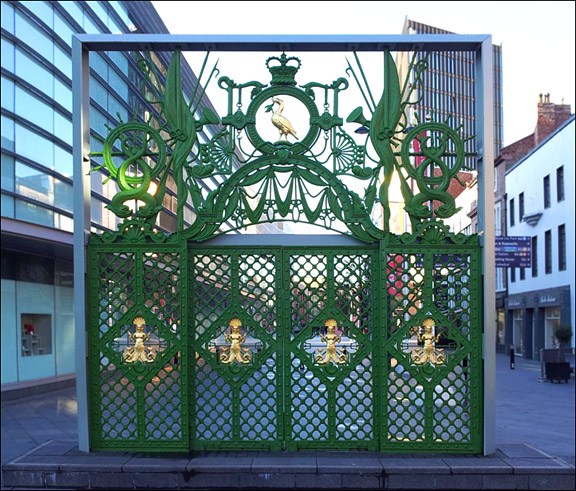
|
 Henry Pooley (1803-78) was born in West Derby, a suburb of Liverpool. He was the third son of Liverpool iron founder Mr Henry Pooley Snr.
Henry Pooley (1803-78) was born in West Derby, a suburb of Liverpool. He was the third son of Liverpool iron founder Mr Henry Pooley Snr.  During the construction of The Liverpool Sailors’ Home (1845-52), it is clear from contemporary reports that John Cunningham, worked closely with Henry Pooley Jnr. on the designs of the iron-work: “three tiers of ornamental cast-iron pilasters with an intermediate range of galleries, filled in with ornamental cast-iron work depicting nautical themes characteristic of the purpose of the building, thereby forming six floors for dormitories, capable of accommodating on each floor forty-four cabins.” Pooley and Cunningham also worked together to re-build the Homes’ interior following the disastrous fire of April 1860 which closed the building for two years.
During the construction of The Liverpool Sailors’ Home (1845-52), it is clear from contemporary reports that John Cunningham, worked closely with Henry Pooley Jnr. on the designs of the iron-work: “three tiers of ornamental cast-iron pilasters with an intermediate range of galleries, filled in with ornamental cast-iron work depicting nautical themes characteristic of the purpose of the building, thereby forming six floors for dormitories, capable of accommodating on each floor forty-four cabins.” Pooley and Cunningham also worked together to re-build the Homes’ interior following the disastrous fire of April 1860 which closed the building for two years. Resolved - That Mr.Cunningham & Mr.Pooley arrange an effectual stop for front gate, and that they give a note conjointly, to the effect that the gate shall be made perfectly secure."
Resolved - That Mr.Cunningham & Mr.Pooley arrange an effectual stop for front gate, and that they give a note conjointly, to the effect that the gate shall be made perfectly secure." “The heavy mass of iron which caused the officer's death lay prone alongside of the front of the building for some time and was an object of curious investigation by morbid passers-by who knew of the sad affair.”
“The heavy mass of iron which caused the officer's death lay prone alongside of the front of the building for some time and was an object of curious investigation by morbid passers-by who knew of the sad affair.” 1951: The Gates Move to Their New Home in Sandwell
1951: The Gates Move to Their New Home in Sandwell